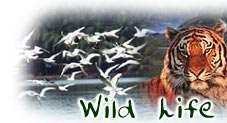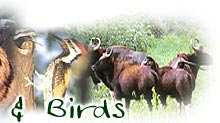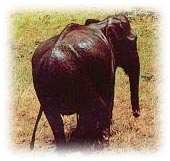

  Neyyar | Peppara | Shenduruny | Parambikulam | Wayanad | Periyar | Idukki | Eravikulam | Chinnar | Thattekkad | Kumarakom Welcome to a world of spellbinding experiences. Welcome to the wild and wonderful in god's own country. Nestled in the lush forests of the western ghats in Kerala are twelve wildlife sanctuaries and two national parks. Each one home to rare animals, birds, reptiles, insects and plants. From the endangered Nilgiri tahr to the lion-tailes macaque. From the atlas moth - the largest in the world, to the travancore evening brown , one of the rarest buterflies in the world. From the Neelakurinji that blooms once every twelve years to podocarpus wallichianus, the only south indian conifer, and skirting these exotic destinations are some of the most delightful trekking trails in the country. At wayanad, nelliampathy, munnar, thekkady, agasthyarkoodam. Some of them adventurouslyexciting. Others enchanting in equal measure. All washed in the spice-scented air of endless acres of plantations, tea, coffee, cardamom, vanilla, pepper, oranges, mangoes. Neyyar
Wildlife Sanctuary (Thiruvananthapuram District)
Acess :Nearest Airport : Thiruvananthapuram (32 Kms),Nearest Railhead : Thiruvananthapuram, connected with Chennai, Mumbai, Delhi, Kashmir. Area :Total : 128 Sq.Km. Core: 60 Sq.Km. Climate : Rainfall : 3000 Mm. Southwest Monsoon : May - July,  The sanctuary strectches from Neyyatinkara Taluk to the Mundanthurai Tiger Reserve in Tamil Nadu. It is the drainage basin of the Neyyar river and its tributaries - Mullayar and Kallar - which originate in Agasthyarkoodam, the second highest peak in Kerala (1868m). Thesanctuary was estahlished in 1958. Wildlife Population Mammals:Elephant, Gaur, Sambar, Barking Deer, Wild Boar, Indian Porcupine, Three-Striped Squirrel, Tiger, Malabar Squirrel, Lion-Tailed Macaque, Mouse Deer, Bonnet Macaque, Nilgiri Tahr, Nilgiri Langur Etc. Reptiles:Cobra, Viper, Python, Rat Snake, Flying Snake, Lizard Etc Avifauna:Common Myna, Kingfisher, White-Breasted Water Hen, Little Green Heron, Woodpecker, House Crow, Koel , Indian Cuckoo, Grey Jungle Fowl, Hoopoe, Jungle Myna, Indian Hill Mayna, Darter, Little Cormorant, Little Agret Etc. Peppara Wildlife Sanctuary (Thruvananthapuram District) Acess:Nearest Airport : Thiruvananthapuram (55 Kms) Nearest Railhead : Thiruvananthapuram, connected with Chennai, Mumbai, Delhi, Kashmir. Area:Total : Total : 53 Sq.Km. Climate:Southwest Monsoon : May - July, Northwest Monsoon October - November , Rainfall : 3000 Mm.  50
kms northwest of Thiruvananthapuram city in Nedumangad Taluk. The catchment
area of the Peppara dam constructed across the Karamana river, was declared
a sanctuary in 1983. There are 13 tribal settlements in the sanctuary - 11
of them in the Athirumala section and 2 in the Thodayar saction. The
sanctuary is accessible from Vithura on the Thiruvananthapuram - Ponmudi
road. 50
kms northwest of Thiruvananthapuram city in Nedumangad Taluk. The catchment
area of the Peppara dam constructed across the Karamana river, was declared
a sanctuary in 1983. There are 13 tribal settlements in the sanctuary - 11
of them in the Athirumala section and 2 in the Thodayar saction. The
sanctuary is accessible from Vithura on the Thiruvananthapuram - Ponmudi
road.Vegetation :Southern hilltop tropical evergreen forests at 1000m above sea level, on less favourable soil and climatic conditions. Wildlife Population Mammals: Elephant, Gaur, Sambar, Barking Deer, Wild Boar, Tiger, Panther, Wild Dog, Malabar Squirrel, Lion-Tailed Macaque, Mouse Deer, Nilgiri Langur Etc. Reptiles:King Cobra And Python. Avifauna: Darter, Little Cormorant, Pied Kingfisher And Egret. Shenduruny Wildlife Sanctuary (Kollam District) Acess:Nearest Airport : Thiruvananthapuram (72 Kms) Nearest Railhead : Thenmala, connected with Chennai, Mumbai, Delhi, Kashmir. Motorable Road connected with Kollam Town and Thiruvananthapuram city. Area:Total : 100.32 Sq.Km. Lake : 26 Sq. Km. Climate:Rainfall : 3000 mm. Pathanapuram taluk, 66 km from Kollam town on the Kollam - Shencotta road. The Shenduruny forest was declared a wildlife sanctuary in 1984. The Name Shenduruny comes from an endemic species of tree called Chenkuruny (gluta travancoria), mainly confined to this region. The artificial lake formed by the parappar dam built across the shenduruny and kulathupuzha rivers occupies the central region of the sanctuary.  Shenduruny
was the cradle of one of the oldest river valley civilisations in India -
one older than Indus valley (4400 - 3700 bc). Remains of a stone age culture
to the mesolithic period, have been excavated from a large cave at the
northwestern part of the Shenduruny river. The case which is large enough to
hold 20 people at a time has paintings similar to the mesolithic paintings
found in the caves of central India. Shenduruny
was the cradle of one of the oldest river valley civilisations in India -
one older than Indus valley (4400 - 3700 bc). Remains of a stone age culture
to the mesolithic period, have been excavated from a large cave at the
northwestern part of the Shenduruny river. The case which is large enough to
hold 20 people at a time has paintings similar to the mesolithic paintings
found in the caves of central India.Vegetation :West Coast Tropical Evergreen Forest, West Coast Tropical Semi Evergreen Forest, Southern Moist Mixed Deciduous Forest. Wildlife Population Mammals: Macaca Radiata, Bonnet Macaque, Gaur, Sambar, Barking Deer, Wild Boar, Indian Giant Squirrel, Three-Striped Palm Squirrel, Lion-Tailed Macaque, Mouse Deer, Elephant, Tiger, Leopard, Nilgiri Langur etc. Parambikulam Wildlife Sanctuary (Palakkad District) Acess:Nearest Airport : Coimbator (100 Km) Nearest Railway Station : Pollachi (60 Km). Area:285 Sq.Km. Water Spread : Parambikulam Lake - 21.2 Sq. Km. Thoonacadavu Lake - 4.33 Sq. Km, Parivarippallam - 2.89 Sq. Km. Climate:Temperature : Low. Mist In The Morning Hours. Rainfall : Average : 1720 Mm. Heavy Rains : June - Aug Tucked away in the valley between the Anamala ranges of Tamil Nadu and the Nelliampathy ranges of Kerala on the majestic western ghats is the Parambikulam wildlife sanctuary. Three dams have been built here by the tamil nadu government under the Parambikulam - Aliyar project. The reservoir harbours several varieties of aquatic fauna. Vegetation :: ideally suited to the growth of teak, large scale teak plantation through artificial reveneration has been encouraged in the sanctuary, and managed in such a way as to restore the forest to its original status. Wildlife Population Mammals: Bonnet Macaque, Lion Tailed Macaque, Nilgiri Langur, Loris, Tiger, Leopard, Jungle Cat, Civet, Mangoose, Fox, Bear, Elephant, Gaur, Nilgiri Tahr, Spotted Deer, Sambar, Barking Deer, Wild Boar, Pangoline Etc. Birds : Carter, Little Cormorant, Black Eagle, Lesser Adjutant Strork, Black Kingfisher, Great Indian Hornbill, Broad Billed Roller, Black Woodpecker. Reptiles :Crocodile, Varanus, Pond Terapin, Cane Turtle, Gecko, Skunk, Chameleon, Snakes Like King Cobra, Spectacled Cobra, Krait, Viper, Python, Green Keel Back, Rat Snake, Vine Snake Etc.Python, Cobra Etc.
Periyar
Tiger Reserve (Idukki District)
Access: Nearest Airport : Madurai (143 Kms) Nearest Railhead : Kumarakom, (114 Kms). Nearest town is Kumily (4km), The entry point to the reserve is Thekkady, which is accessible by good roads from Madurai, Cochin & Thiruvananthapuram. Area:Total : 777 Sq.Km. Core: 350 Sq.Km. Periyar Lake 26 Sq. Km, Forest Cover : 360 Sq.K.M.  This
is one of the most prestigious regions on the high ranges of the western
ghats. One of the world's most fascinating natural wildlife sanctuaries, the
Periyar reserve is noted for its geomorphology, diverse wildlife and
beautiful landscape. The drive to Thekkady itself is enchanting as the road
winds through Tranquil countryside, rich plantations and thick jungles. The
sanctuary, declared a tiger reserve in 1978 under the project tiger scheme,
attracts travellers from all over the world. This is the only sanctuary in
India where the wild elephant can be observed and photographed at close
quarters. There are two watch towers in the Periyar forest. This
is one of the most prestigious regions on the high ranges of the western
ghats. One of the world's most fascinating natural wildlife sanctuaries, the
Periyar reserve is noted for its geomorphology, diverse wildlife and
beautiful landscape. The drive to Thekkady itself is enchanting as the road
winds through Tranquil countryside, rich plantations and thick jungles. The
sanctuary, declared a tiger reserve in 1978 under the project tiger scheme,
attracts travellers from all over the world. This is the only sanctuary in
India where the wild elephant can be observed and photographed at close
quarters. There are two watch towers in the Periyar forest.The Periyar lake: formed by the construction of the dam across the Uullaperiyar river in 1895, the lake harbours within itself a unique aquatic eco system. The numerous little islets in the lake are witness to the intricate inherent interrelationship among the terrestrial aquatic and subterranean life forms. A boat cruise on the lake is perhaps the best way to watch the wildlife in the reserve. Best time to visit: October - May entry to the reserve 0600 - 1800 hrs Vegetation : over 1800 flowering plants including 171 grass species and 143 species of orchids. The only south indian conifer podocarpus wallichianus grows here. Wildlife Population Mammals:
35 Species Including The Wild Elephant, Tiger, Panther, Wild Dog, Gaur, Sambar, Barking Deer, Wild Boar, Sloth Bear, Malabar Giant Squirrel, Lion-Tailed Macaque, Civet, Leopard, Nilgiri Tahr, Nilgiri Langur Etc. Reptiles: King cobra, Viper, Krait, a number of non poisonous Snakes, Bicoloured Frogs, Tortoise and Crocodiles. Avifauna: 265 Species including Migrants. The great Indian Hornbill, Peafowl, Brahminy kite and black - Winged Kite. Aquatic birds Like Darter, Little Cormorant, Kingfisher, Black - Necked stork Etc. Idukki Wildlife Sanctuary (Idukki District) Access:Nearest Airport : Madurai (143 Kms) nearest Railhead : Kumarakom, (114 Kms). nearest town is Kumily (4km), the entry point to the Reserve is Thekkady, Which is Accessible by Good Roads from Madurai, Cochin & Thiruvananthapuram. Area: Total : 77 Sq.Km. Climate:Monsoon : June - November, Rainfall : 2200 Mm.  40
kms from Thodupuzha town. Spread over the Thodupuzha and Udumpanchola taluks
of Idukki district, the sanctuary was formed in 1976. The Idukki arch dam,
the first major hydroelectric project in Kerala, is situated here. The 33
sq.km scenic lake around the santruary - the Idukki reservoir - is formed by
the three dams Cheruthoni, Idukki and Kulamavu. 40
kms from Thodupuzha town. Spread over the Thodupuzha and Udumpanchola taluks
of Idukki district, the sanctuary was formed in 1976. The Idukki arch dam,
the first major hydroelectric project in Kerala, is situated here. The 33
sq.km scenic lake around the santruary - the Idukki reservoir - is formed by
the three dams Cheruthoni, Idukki and Kulamavu.Vegetation :Tropical Dense Evergreen Forest : White Pine, Kuntherekka Pine, Punnappa, Bhadraksham, Palai, Vediplavu, Maravuri, Vayana Etc. Wildlife Population Reptiles:Elephant,
Deer , Bear, Leopard Tiger, Wild Pig Etc.
Mammals: Cobra, Viper, Python, Rat Snake, Etc. Reptiles:Hornbill, Kingfisher, Woodpecker. Eravikulam National Park (Idukki District) Acess:Nearest Airport : Cochin (155 Kms) Nearest Railhead : Aluva (114 Kms) From Munnar. Area:Total : 97 Sq.Km. Core: 350 Sq.Km. Periyar Lake 26 Sq. Km, Forest Cover : 360 Sq.K.M. Climate:this is one of the wettest regions of the world. Rainfall : 4500 mm. Frost is common in the winter months - december to february.  15
Km North Of Munnar. Established In 1975 To Protect The Nilgiri Tahr, The
Eravikulam Sanctuary Was Declared A National Park In 1978 Considering Its
Ecological, Faunal, Floral, Geomorphological And Zoological Significance.
The Park Is Breathtakingly Beautiful And Comparable To The Alpine Ranges.
This Land Of The Neelakurinji Is 7 Km From The Rajamalai Hills. 15
Km North Of Munnar. Established In 1975 To Protect The Nilgiri Tahr, The
Eravikulam Sanctuary Was Declared A National Park In 1978 Considering Its
Ecological, Faunal, Floral, Geomorphological And Zoological Significance.
The Park Is Breathtakingly Beautiful And Comparable To The Alpine Ranges.
This Land Of The Neelakurinji Is 7 Km From The Rajamalai Hills.Vegetation :Forest Types : Rolling Grasslands and on a Higher Level, Shola Forest. Wildlife Population Mammals: Tigers , Panther, Wild Dog, Civet Cats, Sloth Bear, Nilgiri Langur, Wild Boar, Nilgiri Tahr etc Chinnar Wildlife Sanctuary ( Idukki District) Access:Nearest Airport : Coimbatore and Cochin. Nearest Railway Station : Pollachi (60 Km) And Aluva (200 Kms). Area:Total : 90.422 Sq.Km. Climate:Rainfall : 100 Mm. Unlike Other Regions In Kerala, Chinnar Gets Only 48 Days Of Rain ( Northeast Monsoon : October - November) Annually.  Located
in the rain shadow region of the western ghats, the sanctary occupies the
forested region on either side of the Marayoor - Udumalped road. This is the
second habitat of the endangered giant grizzled squirrel of india. The
location of sanctuary offers the unique advantage of watching its
fascinating wildlife at close quarters from the road without venturing deep
into the jungle. The Marayoor sandal forest and the beautiful Thoovanam
waterfalls are located here Located
in the rain shadow region of the western ghats, the sanctary occupies the
forested region on either side of the Marayoor - Udumalped road. This is the
second habitat of the endangered giant grizzled squirrel of india. The
location of sanctuary offers the unique advantage of watching its
fascinating wildlife at close quarters from the road without venturing deep
into the jungle. The Marayoor sandal forest and the beautiful Thoovanam
waterfalls are located hereVegetation :Forest Types : Thorny Scrub Forest With Xerophytic Species. Dry Deciduous Forests, High Sholas And Wetlands. Wildlife Population Mammals: Elephant, Gaur, Spotted Deer, Panther, Sambar, The Endangered Giant Grizzled Squirrel, Hanuman Langur, Rabbit Etc Wayanad Wildlife Sanctuary (Wayanad District) Acess:Good Roads And Rails Connect The Sanctuary with Kozhikode (Calicut), Mysore and Ooty - all Within a 110 Km Radius.The nearest airport is Kozhikode (Calicut). Climate:Warm Months: March - May, Moonsoon : June - August. Rainfall : 2000 mm.  Established in 1973, the Wayanad wildlife sanctuary is contiguous to the protected area network of Nagarahole and Bandipur of Karnataka and Mudumalai of Tamil Nadu. Rich in biodiversity, the sanctuary is an integral part of the Nilgiri biosphere reserve, which was established with the specific objective of conserving the biological heritage of the region. Vegetation :: Moist Deciduous Forest : Teak, Maruthi, Karimaruthi, Rosewood, Venteak, Vengal, Chadachi, Mazhukanjiram, Bamboo etc. Wildlife
Population
Mammals: Elephant, Tiger, Panther, Jungle Cat, Monkey, Wild Dog, Bison, Deer, Bear Etc. The Elephant Occupies Prime Position Interstate Seasonal Migration Of Elephants Is Common. The Tiger Population In The Sanctuary Is Fairly Good. Birds : Peacock, Babbler, Cuckoo, Owl, Woodpecker, Jungle Fowl Etc. Reptiles :Monitor Lizard And A Variety Of Snakes. Thattekkad Bird Sanctuary (Ernakulam (Cochin) District) Acess:Nearest Airport : Cochin (71 Km) Nearest Railway Station : Aluva (48 Km). Area:25.16 Sq.Km. The Thattekkad bird sanctuary, constituted in 1983, occupies the catchment area of the Bhoothathankettu dam. The only one of its kind in Kerala, this sanctuary was designed by Dr. Salim Ali, the renowned ornithologist. He is reported to have identified 167 bird species and his student - dr. Sugathan, 207. In addition, the bombay natural history society has identified 253 species here. The Thattekkad bird sanctuary attract nature lovers from all over the world. Vegetation :Tropical Evergreen Forest : Vellapine, Karanjili, Palai, Kunthirikam, Bhadraksham, Kanala, Kurangatti etc. Wildlife Population Mammals: Leopard, Bear, Porcupine Etc. The Elephant Is An Occasional Visitor. Birds : Indian Roller, Cukoo, Common Snipe, Crow Pheasant, Jungle Nightjar, Kite, Grey Drongo, Malabar Trogon, Woodpecker, Large Pied Wagtail, Baya Sparrow, Grey Jungle Fowl, Indian Hill Myna, Robin, Jungle Babbler And Darter. Reptiles :Python, Cobra etc. Kumarakom Bird Sanctuary Located on the banks of the vembanad lake, the kumarakom bird sanctuary, an ornithologist's paradise, is a favourite haunt of migratory birds like the siberian stork, egret, darter, heron and teal. Other common varieties like the woodpecker, skylark, crane, water hen and parrots can also be spotted here. A cruise along the vembabad lake is the best way to experience the sanctuary. Pathiramanal, an enchanting island on the lake, can be accessed by boat from here. Best Time:Between June And August. (Migratory Birds : November - February) Pathiramanal : This 10 acre island on the backwaters is home to may rare varieties of migratory birds from different parts of the world. Neyyar | Peppara | Shenduruny | Parambikulam | Wayanad | Periyar | Idukki | Eravikulam | Chinnar | Thattekkad | Kumarakom  |